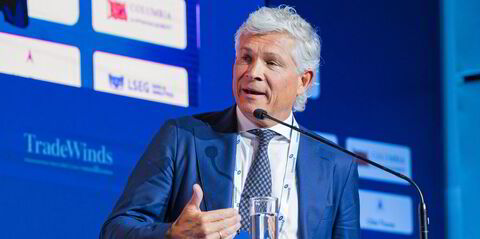A sanctioned Sovcomflot tanker has reportedly carried out a ship-to-ship transfer of Russian crude off Singapore.
Bloomberg said the Russian state shipowner’s 157,300-dwt suezmax SCF Primorye (built 2009) offloaded the Urals oil 70 miles (113 km) east of Singapore.
The vessel had travelled 12,000 km after loading the crude in the Black Sea port of Novorossiysk in April.
The SCF Primorye was sanctioned by the US Treasury Department’s Office of Foreign Assets Control last October, after which it did not load oil for about six months.
Bloomberg said the vessel stopped showing on AIS after arriving off Singapore, but satellite imagery revealed that the transfer was made on 3 June.
The receiving tanker was named as another suezmax.
The vessel manager listed in shipping databases told TradeWinds it does not own or operate the receiving tanker and is taking legal action over the report.
The ship will probably head to China, according to Kpler.
Bloomberg said it identified the two vessels based on their size, deck configuration and colour.
TankerTrackers confirmed their identification, the report said.
AIS data showed the SCF Primorye underway off Vietnam on Tuesday, heading to Hong Kong for arrival on 15 June.
Sovcomflot has been contacted for comment.
In May, TradeWinds reported that most of the Russian group’s sanctioned tankers remained inactive, but it was noted that the SCF Primorye was heading to Asia with cargo on a voyage that had the potential to prove pivotal for the group.
Trading more difficult
Although the tanker was broadcasting Singapore OPL (outside port limits) as its next destination, well-placed sources in the city state told TradeWinds that it was not scheduled to call at the Port of Singapore or its anchorages.
It was believed the ship would transit the Singapore Strait en route to China.
Sovcomflot has admitted that Western sanctions are making trade difficult.
Bloomberg tallied 40 tankers sanctioned by the US since October for involvement in Russia’s oil trade, mostly for price cap breaches.
But a successful discharge for the SCF Primorye could encourage more tankers to attempt voyages.
The SCF Primorye was the first vessel to be designated in October.
Twenty other SCF Group ships have since been sanctioned.
Most of these are anchored and empty.
Eight were anchored off Russia’s Pacific ports of Vladivostok and Nakhodka, some for up to five months.
Another had headed from there in ballast towards the Suez Canal, while another had been dry-docked in China.
Seven more SCF Group ships were idle in the Black Sea, shipping data showed. The first of these arrived in December.
The other three were in the Baltic Sea. Two were off the Russian export terminal of Ust-Luga and the other had been off Estonia since late February.




